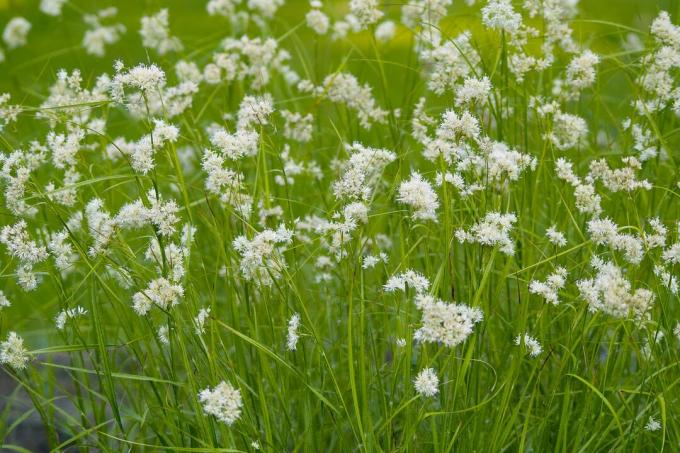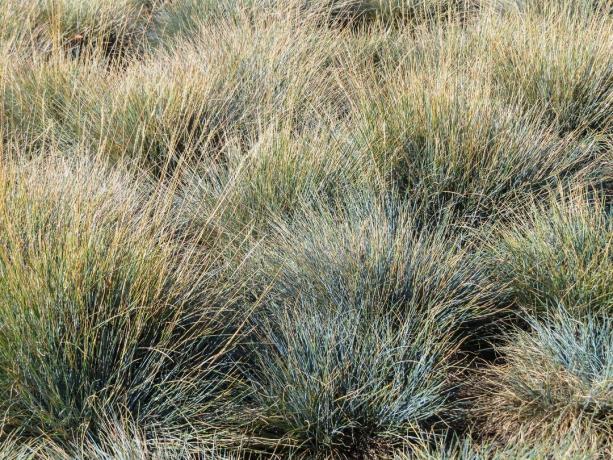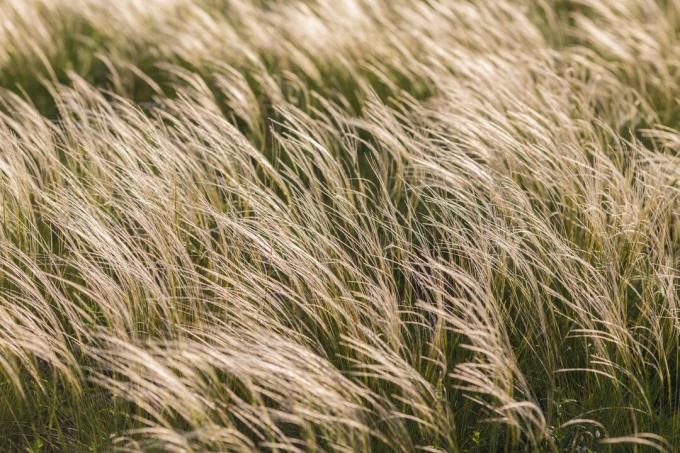Grasses usually dry up in winter. Here is a selection of hardy grasses that, with proper care, will sprout again next spring.

In addition to the heart-shaped, oval or round foliage of smaller or larger perennials, the long lanceolate leaves of grasses (Poales) an interesting contrast. If they are not cut back in autumn, grasses can provide a stage for impressive natural spectacles. Because who doesn't like to look at the hoarfrost on the long stalks and fruiting bodies when the winter sun shines on them? And last but not least, some grasses are captivating - such as the lamp cleaner grasses (Pennisetum) - especially in winter with their sometimes strikingly beautiful fruit stands. It is definitely worth planting a selection of hardy grasses in your garden.
contents
- Hardy grasses: Particularly robust species and varieties
- Hardy grasses: As a privacy screen
- Hardy grass for the bucket
- Hardy grasses: Maintain & cut properly
- Water & fertilizer
- Care for grasses in pots
- Cutting hardy ornamental grasses
Hardy grasses: Particularly robust species and varieties
When you think of particularly hard-wearing grasses, it might come first Carex and Luzula in mind. In fact, these two representatives are very robust and can be found in many private gardens. In addition to the practical component, there is also an advantage in the variety of colors of the stalks. The following grasses can hopefully offer you new ideas and design options:
-
Carex morrowii"Variegata"
The robust ornamental grass impresses with its dark green leaves on the inside, which are lined with narrow, high-contrast and whitish edges. It grows nice and compact and small (height up to 30 cm). -
Carex morrowii"Aureovariegata"
This grass is particularly similar to its close relative Variegatataˈ, but the narrow leaf edges are golden yellow.

-
Luzula nivea
Also known as snow marbles, this grass shines with its delicate, deep green leaves. In summer we especially like the pretty, white flower pods. -
Luzula sylvatica
This is a native game that is characterized by its typically shiny leaves. The forest marbel, as it is also known, still grows very well even in dry, shady locations.

Hardy grasses: As a privacy screen
When you hear the word “privacy protection”, you usually think of green strips of hedges or masonry structures. But it is easy to forget that grass species also reach such heights and densities. Even in winter, the grasses - albeit dried up - can protect against unwanted looks. In spring, however, they have to be cut back so that year after year there is a time without protective grass. Fortunately, the grass quickly regains its original height. Anyone different from the ordinary Book- (Fagus) or Cherry laurel hedges (Prunus laurocerasus) remove as a privacy screen and want to try something new, you should therefore make a note of the following ornamental grasses and maybe even implement these ideas in your own garden:
-
Riding grass (Calamagrostis x acutiflora)
This plant is a stately, stiffly upright growing ornamental grass. It can be used on the edges of the beet and act as an attractive privacy screen. Due to its fruit stands it also has a high jewelry value in winter. It is particularly suitable for sunny locations, reaches a height of up to 130 cm and is in full bloom in July and August. -
Pile tube (Arundo donax)
The pile tube originally comes from southern Europe. Although it rarely blooms in our regions, it reaches an unbeatable height of up to 3 meters. It is advisable to plant the individual pile tubes offset due to their size. Accordingly, you should plan enough space.

-
Chinese reed (Miscanthus sinensis ˈSilver penˈ)
Chinese reed is particularly attractive near water or in connection with the surrounding architecture. Due to its size (up to 2 meters), it can also protect from prying eyes. The flower panicles often persist into winter and are of high decorative value. -
Miscanthus giganteus
Another great representative of the Chinese ornamental grass is Miscanthus giganteus. This does not form any runners that could affect nearby beds and lawns, and is very opaque in the winter months. The ideal location here ranges from sunny to partially shaded. If the ornamental grass feels comfortable, it grows about 3 meters in height.

Hardy grass for the bucket
Certain grasses can look extremely attractive in pots - in company or individually. Of course, you should always make sure that the container is large enough, as large plants in small containers can never reach their full potential and quickly lose their decorative value. The size of the pot should be about two to three times the size of the root ball of the plant. The bucket is also well protected from the winter cold by placing it close to a house wall or wrapping it with fleece. This prevents the rhizome from freezing and ensures the survival of the plant. In this context, frost resistance should be considered when choosing a plant, because every plant has its own Home in other climes with different weather conditions and there are also very different frost zones in Germany gives. For you as a gardener, this means that you have to provide thicker winter protection in Bavaria than in Hamburg, as the freezing temperatures can last longer here. The following ornamental grasses are suitable for the tub in the garden or in the winter garden:
-
Blue fescue (Festuca cinerea)
The grass with the blue-gray foliage forms beautiful hemispherical clumps. It is insensitive to drought and reaches a height of about 15 cm. -
Bearskin fescue (Festuca gautieri)
The evergreen pads of the bearskin fescue consist of fresh green, needle-shaped leaves. They are so close that they are reminiscent of the fur of a bear.

-
Real sheep fescue (Festuca ovina)
The real sheep fescue forms beautiful hemispherical clumps with its gray-blue leaves. It blooms greenish-yellow from May to July. -
Blue schiller grass (Koeleria glauca)
This gray-green grass is also native to Europe. With its inflorescences, the blue Schillergrass can reach heights of up to 40 cm in the open air; in pots it usually remains a little smaller. -
Tender feather grass (Stipa tenuissima)
As the name suggests, the delicate feather grass is characterized by its very delicate and soft leaves. From June to July you can see beautiful silver to white flowers.

Hardy grasses: Maintain & cut properly
As a rule, the care of ornamental grasses is not particularly complicated. Most of the ornamental grass species prefer a nutrient-rich and humus-rich soil. Representative like Calamagrostis or Miscanthus feel particularly comfortable in the sun, whereas Carex thrives in the shade. Overall, however, the tolerance to light conditions is very good and shady grasses can sometimes grow in sunnier locations.
But be careful: At low temperatures, ground frost can occur, which makes it difficult to absorb water. In strong sunlight, the plant loses a lot of water, but can draw little or no water from the soil. It is therefore advisable not to place hardy plants in full sun.

Water & fertilizer
Ornamental grasses also have an above-average tolerance to drought, which is why regular watering is not necessary, except in very long periods with little rain. The nutritional requirements of the small to medium-sized grasses are very limited. It is sufficient to enrich these bed sections with a little compost in the spring, so that the soil life through the decomposition of the compost guarantees a small but long-term supply. In the case of large grasses, which are also excellent as privacy screens, you can also choose to add Liquid fertilizers do without, because there is a risk that the already large stalks will become even larger and thus more unstable and ultimately kink. The pruning measures for evergreen grasses are limited to removing dead leaves and inflorescences. The latter should be removed to avoid uncontrolled spreading into other beds.

Care for grasses in pots
If you adhere to the following points, ensure you have an all-round carefree package for every ornamental grass in the bucket:
- Sufficient drainage in the form of potsherds or clay balls on the bottom of the bucket
- Use nutrient-rich, but not too heavy, substrate
- Regular watering prevents the root ball from drying out
- Regular repotting keeps the plant and the soil in the tub healthy and ensures vitality and flowering potential
Cutting hardy ornamental grasses
The pruning measures for the ornamental grasses are limited to clearing out the brown and withered parts of the plant as well as to a strong pruning in spring. This guarantees that the grasses can sprout again optimally and form a new, vital eyrie.
Further hardy plants we have compiled for you here.



